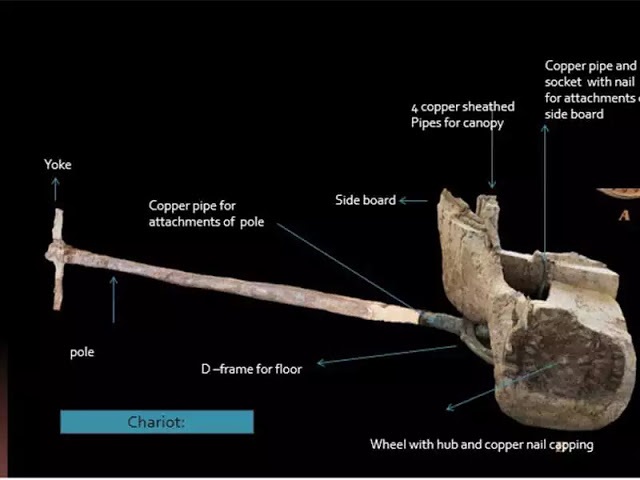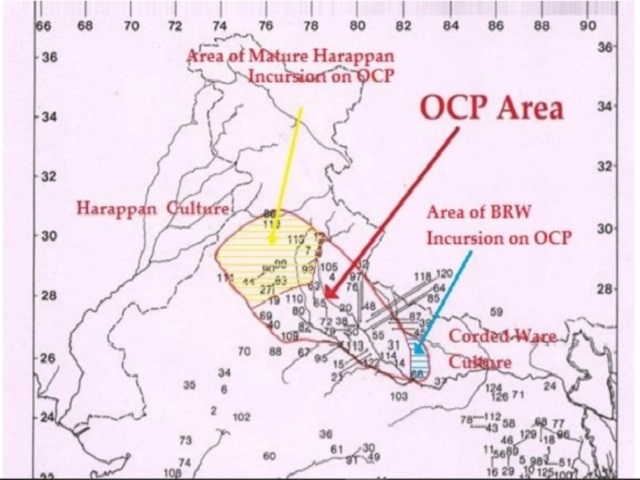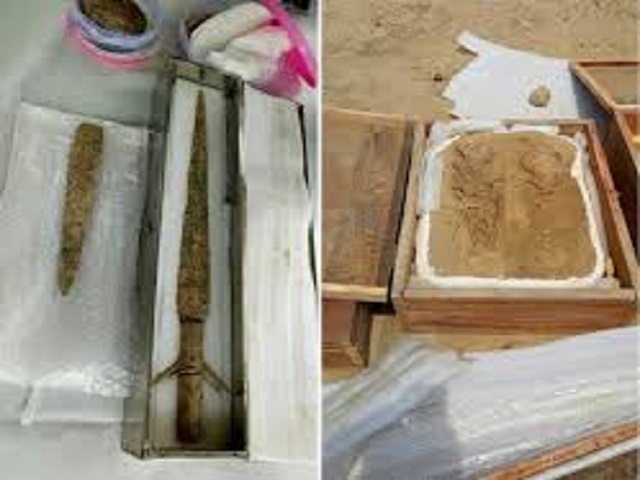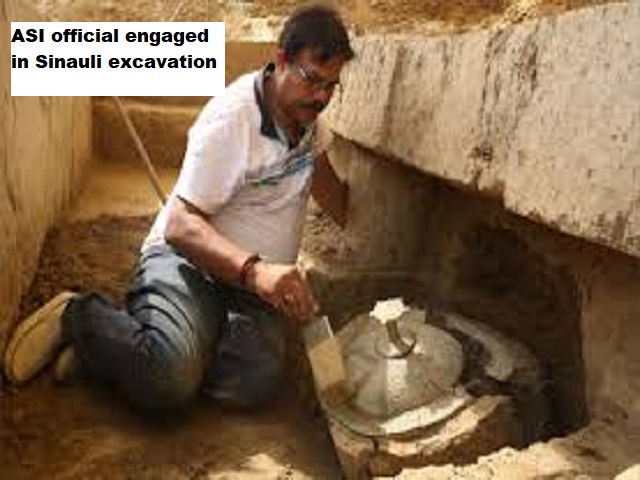Why is Sinauli in News?
Sinauli has been in news as a new documentary by Discovery Channel has been telecast recently based on this small archaeological site.
There has been evidence of warrior class' existence of around 2000 BCE discovered at this place.
Where is Sinauli?
Sinauli is situated in Uttar Pradesh's Baghpat district, India.It is 70 kilometres away from New Delhi situated at the doab of Ganga and Yamuna rivers.

Sinauli Excavation 1.0 in 2005:
- The excavations first began in 2005 and within a year 116 burial sites were discovered. Due to this, it was referred to as one of India's largest known necropolis in the Chalcolithic period.
- The burial sites are different from Indus Valley Civilization. The coffins are 4 legged and the tombs had underground chambers.
- In the tombs are found systematically arranged vases, bowls and pots near the body.
- There is rice found in those pots buried along with the bodies of the troops
- In one coffin upon excavation, 8 anthropomorphic figures (something that looks like humans) were found on it.
- One thing that is extraordinary is that the burials were similar to vedic culture and not Indus Valley culture
- Impressions of cloth to wrap the bodies suggests purification of corpses like those practiced in Hindu customs today.
.jpg)
Sinauli Excavation 2.0 in 2018:
- After 2005-06 the excavations ended.
- It came into light again in 2018 when a farmer reported to have found antiquities in the land while ploughing the field. As per Hindustan Times report, the farmer found pieces of copper in the ground after which the ASI came into action.
What was found in Excavation 2.0 in 2018?
- After reporting of copper antiques, the ASI started the dig.
- They found horse drawn chariots which were almost 5000 years old. The chariots found have a fixed ankle linked through a long pole to a small yoke. This ankle, chassis and wheel shows similarity to the modern chariots. These chariots are thought to have been drawn by animals, preferably horses.
- Many weapons like copper antenna swords, war shields etc were found
- They also found wooden for legged coffins this time along with pottery.
- Also a whip to indicate to the animals has been found, which means the tribe that lived here controlled the animals
- Along with the male warriors, female warriors have also been found buried with their swords.
- However their legs around ankles had been removed before they were buried.
- The region is expected to be fertile and suitable for agriculture. The excavation hints at a large kingdom's existence here.

About Pottery Found:
- The pottery found here is Ochre Colored Pottery (OCP) culture. This is similar to Harappan culture but is different from it in many other aspects.
- OCP culture has been found in late mature Harappan civilization

Carbon Dating of the Objects:
- Once the carbon dating of the objects was done they were found to be 3800 years old. This means the civilization was alive in 1800 BC.
- The process of carbon dating was done in the Birbal Sahni Institute of Palaeosciences in Lucknow. The technique used was C-14 dating technique.
- The human remains were inspected by the Deccan College, Pune and a lab in Hyderabad conducted the DNA research.

Role of Archaeological Survey of India:
- After the discoveries made in 2018, the ASI took the place under its protection and it fell under the Ancient Monuments and Archaeological Sites and Remains Act 1958.
- The 28.67 hectare site is under the protection of the Central Government and is recognised as the place of national importance
- The development work of the ASI is subject to Central Government rules here now
- All the unearthed objects would be kept at the ASI institute of Archaeology now.

Significance of the Excavation:
- Since the artifacts belong to the same age as the late mature Harappan era, it can reveal clues to the decline of Indus Valley Civilizations.
- There is still very less evident link between the Late Harappan age and the Chalcolithic and the Vedic age. The excavations provide a hint to these links.
- An idea of a warrior class' existence between 2000 to 1800 BCE arouses interest of the historians and a peek into the early Hindu culture.
It was till now thought that the Indus Valley Civilization when faced doom, the citizens shifted to the Ganga Yamuna doab, but since the Sinauli excavation it has been evident that this site co-existed with the Harappan Civilization. This opens many ends of the history of civilization while closes many others.
GK Questions and Answers on the Art and Architecture of Harappa Civilization
Comments
All Comments (0)
Join the conversation